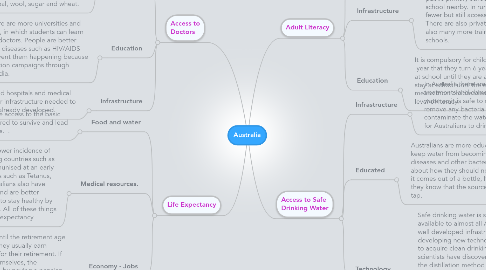
1. Life Expectancy
1.1. Food and water
1.1.1. Most Australians have access to the basic food and water required to survive and lead long and healthy lives. .
1.2. Medical resources.
1.2.1. Australians have a much lower incidence of disease than in developing countries such as Ethiopia. Children are immunised at an early age against many diseases such as Tetanus, Diptheria and Polio. Australians also have better access to Doctors and are better educated about the need to stay healthy by eating well and exercising. All of these things contribute to a longer life expectancy
1.3. Economy - Jobs
1.3.1. Most Australians work until the retirement age of 65. During this time they usually earn enough money to save for their retirement. If they cannot support themselves, the Government helps them by paying a pension. Financial resources help Australians to live longer, healthier lives as they can afford access to health care when it is needed.
2. Access to Doctors
2.1. Resources
2.1.1. Medical facilities are more available, partly because we have a health system that is funded by the Governnment. The government taxes its citizens and uses this money to provide hospitals and health care. Australia also has a higher GDP per capita, which means we make more money from products we export e.g. coal, wool, sugar and wheat.
2.2. Education
2.2.1. In Australia, there are more universities and medical schools, in which students can learn and train to be doctors. People are better educated about diseases such as HIV/AIDS and how to prevent them happening because of public education campaigns through schools and media.
2.3. Infrastructure
2.3.1. It is easier to build hospitals and medical practices as other infrastructure needed to support them is already developed.
3. Adult Literacy
3.1. Rate
3.1.1. At least 90 per cent of people over the age of 15 can read and write.
3.2. Infrastructure
3.2.1. There are many more schools in Australia. In the capital cities, most suburbs have a public primary school and often a public high school nearby. In rural areas, schools are fewer but still accessible to most children. There are also private schools. There are also many more trained teachers to work in schools.
3.3. Education
3.3.1. It is compulsory for children to start school in the year that they turn 6 years of age. Children stay at school until they are at least 15. Most children stay at school until the end of year 12. This means most children leave school with a high level of lteracy.
4. Access to Safe Drinking Water
4.1. Infrastructure
4.1.1. In Australia there are proper sewerage treatments and dams that store and clean the water so it is safe to drink. This helps to remove any bacteria or parasites that may contaminate the water, so it is clean and safe for Australians to drink.
4.2. Educated
4.2.1. Australians are more educated about how to keep water from becoming contaminated with diseases and other bacteria. They also taught about how they should not drink water unless it comes out of a bottle, has been boiled, or they know that the source is safe e.g. a family tap.
4.3. Technology
4.3.1. Safe drinking water is something that is available to almost all Australians thanks to well developed infrastructure. Australia is also developing new technology that can be used to acquire clean drinking water. For example, scientists have discovered that they can use the distillation method to separate the salts from the fresh water in sea water. This means that our country will always have a permanent water source and never run out of water. Australia is also helping to produce and provide water purifying systems for developing countries like Ethiopia, who can't afford them themselves.
